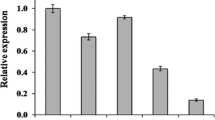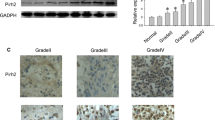Abstract
Glioma is the most common primary central nervous system tumor. Despite considerable research effort, little progress has been made in the therapeutic treatment of this disease. Protein kinase Cε (PKCε), an important intracellular signaling molecule, modulates diverse cellular functions, including cell proliferation, apoptosis, invasion and differentiation. The aim of the study is to investigate whether knockdown of PKCε expression by RNA interference (RNAi) could affect the growth, apoptosis and invasion of human glioma cells, and the involvement of the signal transducer and activator of transcription 3 (Stat3) signaling pathway in these effects. Our data showed that knockdown of PKCε expression inhibited proliferation, induced apoptosis and decreased invasiveness of human glioma cell lines U251 and U87, as well as suppressed the growth of U87 cell-derived tumors in nude mice. Moreover, PKCε physically interacts with Stat3, and knockdown of PKCε expression attenuated Stat3Ser727 phosphorylation and B-cell lymphoma-extra large (Bcl-xL) expression in the two human glioma cell lines. These results support an important role for PKCε in glioma cell growth, apoptosis and invasion, and PKCε exerting its above effects at least in part through Stat3. Thus, PKCε has the potential to be an attractive therapeutic target for glioma therapy.











Similar content being viewed by others
References
Aziz MH, Manoharan HT, Verma AK (2007a) Protein kinase Cε, which sensitizes skin to sun's UV radiation–induced cutaneous damage and development of squamous cell carcinomas, associates with Stat3. Cancer Res 67:1385–1394
Aziz MH, Manoharan HT, Church DR, Dreckschmidt NE, Zhong W, Oberley TD, Wilding G, Verma AK (2007b) Protein kinase Cε interacts with signal transducers and activators of transcription 3 (Stat3), phosphorylates Stat3Ser727, and regulates its constitutive activation in prostate cancer. Cancer Res 67:8828–8838
Aziz MH, Hafeez BB, Sand JM, Pierce DB, Aziz SW, Dreckschmidt NE, Verma AK (2010) Protein kinase Cvarepsilon mediates Stat3Ser727 phosphorylation, Stat3-regulated gene expression, and cell invasion in various human cancer cell lines through integration with MAPK cascade (RAF-1, MEK1/2, and ERK1/2). Oncogene 29:3100–3109
Basu A, Sivaprasad U (2007) Protein kinase Cepsilon makes the life and death decision. Cell Signal 19:1633–1642
Baxter G, Oto E, Daniel-Issakani S, Strulovici B (1992) Constitutive presence of a catalytic fragment of protein kinase C epsilon in a small cell lung carcinoma cell line. J Biol Chem 267:1910–1917
Brantley EC, Benveniste EN (2008) Signal transducer and activator of transcription-3: a molecular hub for signaling pathways in gliomas. Mol Cancer Res 6:675–684
Bromberg J (2002) Stat proteins and oncogenesis. J Clin Invest 109:1139–1142
Bromberg JF, Wrzeszczynska MH, Devgan G, Zhao Y, Pestell RG, Albanese C, Darnell JE Jr (1999) Stat3 as an oncogene. Cell 98:295–303
Chen F, Xu Y, Luo Y, Zheng D, Song Y, Yu K, Li H, Zhang L, Zhong W, Ji Y (2010) Down-regulation of Stat3 decreases invasion activity and induces apoptosis of human glioma cells. J Mol Neurosci 40:353–359
Dasgupta A, Raychaudhuri B, Haqqi T, Prayson R, Van Meir EG, Vogelbaum M, Haque SJ (2009) Stat3 activation is required for the growth of U87 cell-derived tumours in mice. Eur J Cancer 45:677–684
Farah CA, Sossin WS (2012) The role of C2 domains in PKC signaling. Adv Exp Med Biol 740:663–683
Galli D, Gobbi G, Carrubbi C, Di Marcantonio D, Benedetti L, De Angelis MG, Meschi T, Vaccarezza M, Sampaolesi M, Mirandola P, Vitale M (2013) The role of PKCepsilon-dependent signaling for cardiac differentiation. Histochem Cell Biol 139:35–46
Garczarczyk D, Toton E, Biedermann V, Rosivatz E, Rechfeld F, Rybczynska M, Hofmann J (2009) Signal transduction of constitutively active protein kinase C epsilon. Cell Signal 21:745–752
Ghosh MK, Sharma P, Harbor PC, Rahaman SO, Haque SJ (2005) PI3K-AKT pathway negatively controls EGFR-dependent DNA-binding activity of Stat3 in glioblastoma multiforme cells. Oncogene 24:7290–7300
Gorin MA, Pan Q (2009) Protein kinase C epsilon: an oncogene and emerging tumor biomarker. Mol Cancer 8:9
Grandis JR, Drenning SD, Chakraborty A, Zhou M-Y, Zeng Q, Pitt AS, Tweardy DJ (1998) Requirement of Stat3 but not Stat1 activation for epidermal growth factor receptor-mediated cell growth In vitro. J Clin Invest 102:1385–1392
Griner EM, Kazanietz MG (2007) Protein kinase C and other diacylglycerol effectors in cancer. Nat Rev Cancer 7:281–294
Hafeez BB, Zhong W, Weichert J, Dreckschmidt NE, Jamal MS, Verma AK (2011) Genetic ablation of PKC epsilon inhibits prostate cancer development and metastasis in transgenic mouse model of prostate adenocarcinoma. Cancer Res 71:2318–2327
Klampfer L (2006) Signal transducers and activators of transcription (STATs): novel targets of chemopreventive and chemotherapeutic drugs. Curr Cancer Drug Targets 6:107–121
Konnikova L, Kotecki M, Kruger MM, Cochran BH (2003) Knockdown of STAT3 expression by RNAi induces apoptosis in astrocytoma cells. BMC Cancer 3:23–32
Liu T-J, Wang M, Breau RL, Henderson Y, El-Naggar AK, Steck KD, Sicard MW, Clayman GL (1999) Apoptosis induction by E2F-1 via adenoviral-mediated gene transfer results in growth suppression of head and neck squamous cell carcinoma cell lines. Cancer Gene Ther 6:163–171
Louis DN, Ohgaki H, Wiestler OD, Cavenee WK, Burger PC, Jouvet A, Scheithauer BW, Kleihues P (2007) The 2007 WHO classification of tumours of the central nervous system. Acta Neuropathol 114:97–109
Mirandola P, Gobbi G, Masselli E, Micheloni C, Di Marcantonio D, Queirolo V, Chiodera P, Meschi T, Vitale M (2011) Protein kinase Cepsilon regulates proliferation and cell sensitivity to TGF-1beta of CD4+ T lymphocytes: implications for Hashimoto thyroiditis. J Immunol 187:4721–4732
Newton A (2003) Regulation of the ABC kinases by phosphorylation: protein kinase C as a paradigm. Biochem J 370:361–371
Nishizuka Y (1995) Protein kinase C and lipid signaling for sustained cellular responses. FASEB J 9:484–496
Ohgaki H, Kleihues P (2005) Epidemiology and etiology of gliomas. Acta Neuropathol 109:93–108
Okhrimenko H, Lu W, Xiang C, Hamburger N, Kazimirsky G, Brodie C (2005) Protein kinase C-epsilon regulates the apoptosis and survival of glioma cells. Cancer Res 65:7301–7309
Rahaman SO, Harbor PC, Chernova O, Barnett GH, Vogelbaum MA, Haque SJ (2002) Inhibition of constitutively active Stat3 suppresses proliferation and induces apoptosis in glioblastoma multiforme cells. Oncogene 21:8404–8413
Sand JM, Hafeez BB, Aziz MH, Siebers EM, Dreckschmidt NE, Verma AK (2012) Ultraviolet radiation and 12-O-tetradecanoylphorbol-13-acetate-induced interaction of mouse epidermal protein kinase Cε with Stat3 involve integration with ERK1/2. Mol Carcinogen 51:291–302
Senft C, Priester M, Polacin M, Schroder K, Seifert V, Kogel D, Weissenberger J (2011) Inhibition of the JAK-2/STAT3 signaling pathway impedes the migratory and invasive potential of human glioblastoma cells. J Neurooncol 101:393–403
Sharif TR, Sharif M (1999) Overexpression of protein kinase C epsilon in astroglial brain tumor derived cell lines and primary tumor samples. Int J Oncol 15:237–243
Shinohara H, Kayagaki N, Yagita H, Oyaizu N, Ohba M, Kuroki T, Ikawa Y (2001) A protective role of PKCepsilon against TNF-related apoptosis-inducing ligand (TRAIL)-induced apoptosis in glioma cells. Biochem Biophys Res Commun 284:1162–1167
Siegel PM, Massague J (2003) Cytostatic and apoptotic actions of TGF-beta in homeostasis and cancer. Nat Rev Cancer 3:807–821
Stupp R, Mason WP, van den Bent MJ, Weller M, Fisher B, Taphoorn MJ, Belanger K, Brandes AA, Marosi C, Bogdahn U, Curschmann J, Janzer RC, Ludwin SK, Gorlia T, Allgeier A, Lacombe D, Cairncross JG, Eisenhauer E, Mirimanoff RO, European Organisation for R, Treatment of Cancer Brain T, Radiotherapy G, National Cancer Institute of Canada Clinical Trials G (2005) Radiotherapy plus concomitant and adjuvant temozolomide for glioblastoma. N Engl J Med 352:987–996
Taylor LP (2010) Diagnosis, treatment, and prognosis of glioma: five new things. Neurology 75:S28–S32
Tobias A, Ahmed A, Moon KS, Lesniak MS (2013) The art of gene therapy for glioma: a review of the challenging road to the bedside. J Neurol Neurosurg Psychiatry 84:213–222
Toton E, Ignatowicz E, Skrzeczkowska K, Rybczynska M (2011) Protein kinase Cepsilon as a cancer marker and target for anticancer therapy. Pharmacol Rep 63:19–29
Turkson J, Jove R (2000) STAT proteins: novel molecular targets for cancer drug discovery. Oncogene 19:6613–6626
Van Kolen K, Pullan S, Neefs JM, Dautzenberg FM (2008) Nociceptive and behavioural sensitisation by protein kinase Cepsilon signalling in the CNS. J Neurochem 104:1–13
Wen PY, Kesari S (2008) Malignant gliomas in adults. N Engl J Med 359:492–507
Wen Z, Zhong Z, Darnell JE Jr (1995) Maximal activation of transcription by Statl and Stat3 requires both tyrosine and serine phosphorylation. Cell 82:241–250
Xu Y, Li X, Zhang S, Shen D, Li H, Wu Y, Qiu Y, Ji Y, Chen F (2012) Targeting Stat3 suppresses growth of U251 cell-derived tumours in nude mice. J Clin Neurosci 19:443–446
Zammarchi F, de Stanchina E, Bournazou E, Supakorndej T, Martires K, Riedel E, Corben AD, Bromberg JF, Cartegni L (2011) Antitumorigenic potential of STAT3 alternative splicing modulation. Proc Natl Acad Sci U S A 108:17779–17784
Zhong Z, Wen Z, Darnell JE Jr (1994) Stat3: a STAT family member activated by tyrosine phosphorylation in response to epidermal growth factor and interleukin-6. Science 264:95–98
Zhou F, Yang Y, Xing D (2011) Bcl-2 and Bcl-xL play important roles in the crosstalk between autophagy and apoptosis. FEBS J 278:403–413
Acknowledgments
This work was supported by the Innovation Program of Shanghai Municipal Education Commission (grant no. 12ZZ100), the Leading Academic Discipline Project of Shanghai Municipal Education Commission ‘Molecular Physiology’ (grant no. J50108), and the National Basic Research Program of China (grant no. 2010CB529806).
Author information
Authors and Affiliations
Corresponding author
Electronic supplementary material
Below is the link to the electronic supplementary material.
ESM 1
(DOC 448 kb)
Rights and permissions
About this article
Cite this article
Xu, Y., Li, Z., Zhang, C. et al. Knockdown of PKCε Expression Inhibits Growth, Induces Apoptosis and Decreases Invasiveness of Human Glioma Cells Partially Through Stat3. J Mol Neurosci 55, 21–31 (2015). https://doi.org/10.1007/s12031-014-0341-4
Received:
Accepted:
Published:
Issue Date:
DOI: https://doi.org/10.1007/s12031-014-0341-4




